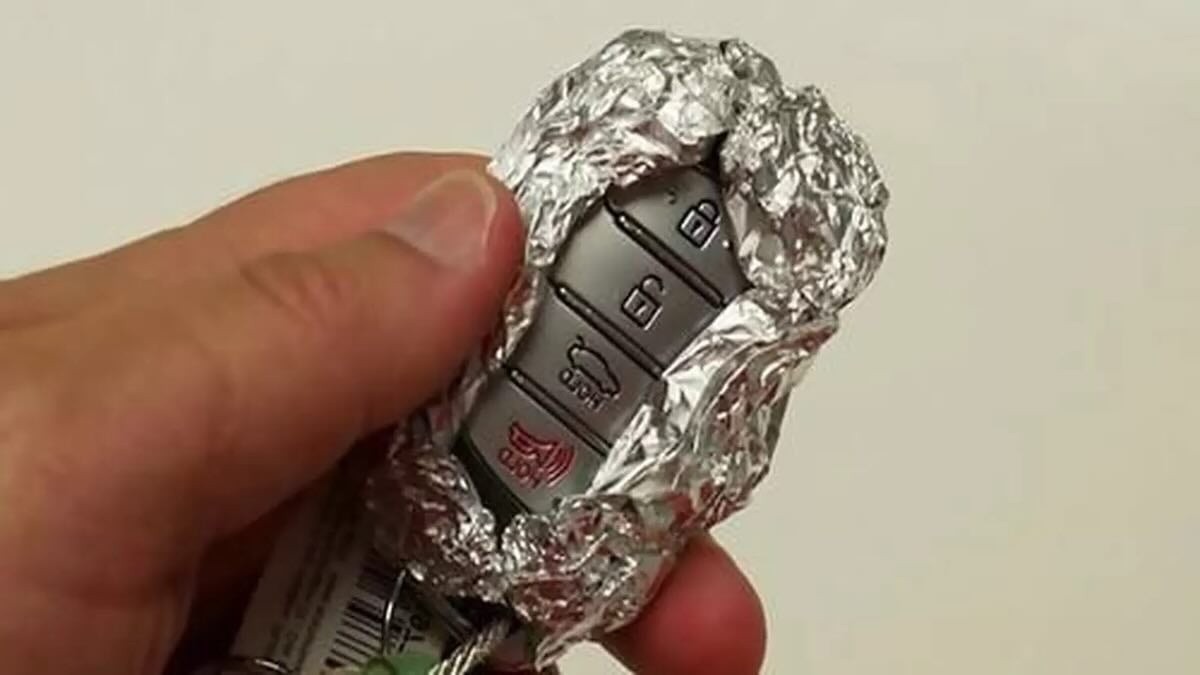Drivers are turning to aluminium foil because it dampens the radio signal from modern key fobs, cutting the risk of relay-style theft. When the fob’s signal is weakened or contained, thieves find it harder to unlock and start a vehicle from outside the home. The idea is simple: create a quick, low-cost shield around the fob until a more durable solution—like a dedicated Faraday pouch or metal case—takes its place. That practicality explains the growing interest.
Why keyless systems create a new theft risk
Keyless entry and push-button start rely on short-range radio communication between the vehicle and its fob. Convenience is high: doors unlock as you approach and the engine starts with a button. The same convenience introduces a gap in protection. If a criminal boosts or relays that radio signal, the vehicle may “think” the fob is nearby and grant access. As keyless tech spreads, more owners look for everyday ways to reduce the signal that thieves try to exploit.
Relay theft explained in plain language
A relay attack uses two devices operated by two people. One device captures the faint signal from the fob inside your home; the other rebroadcasts it near your car. The car accepts the amplified signal and opens. Foil or a Faraday container weakens or blocks that original signal, making the first step—capture—far less reliable.
How foil affects radio signals and what it can and cannot do
Aluminium foil forms a quick, low-tech Faraday shield. Wrap the fob completely and radio waves struggle to pass through. The result is fewer successful signal captures outside your walls or near your front door. Foil is not stylish and can tear, but it’s cheap, immediate and reversible. According to fact-checking and expert commentary, it’s an incremental barrier rather than a silver bullet; think of it as buying time while you adopt longer-term defenses.
Wrapping car keys correctly: quick home checks
Cover the fob fully with no gaps at seams or corners. Test by standing near the car: if doors no longer respond and the start button fails, the shield is working. If it still works intermittently, add a layer or switch to a rigid metal tin or a purpose-built Faraday pouch.
Mistakes that defeat the shield
Thin, crumpled foil with holes leaks signal. Partial wraps that leave edges exposed do the same. Key hooks by the front door can still allow capture if the wrap loosens. Bags with decorative “metallic” linings are often cosmetic, not conductive. Replace worn pouches and re-test regularly.
Everyday defenses that raise the bar for thieves
Layering simple habits matters more than any single trick. Store fobs away from entry points and windows, ideally in a metal box, tin, or certified Faraday sleeve. Keep spare fobs shielded as well; an unprotected spare can undo every other measure. When your car offers it, enable sleep modes or motion-sensor fob settings that put the fob to “rest” when unused. Park with intention: a garage or well-lit, camera-covered spot deters opportunists and shortens the time thieves can experiment with relays.
Simple routine to protect car keys
Set a home base for your fob—a small lidded metal container or quality Faraday pouch placed away from doors. Drop the fob in the container as soon as you return, and keep the spare there too. Add a monthly reminder to test shielding: walk to the car, try the handle, and attempt a start. If it works, refresh the foil or replace the pouch.
What experts and fact-checkers say, plus practical limits
Industry groups and motoring organizations have flagged the rise of keyless-enabled thefts; according to the American Automobile Association, the trend has been notable across vehicles equipped with keyless ignition. Snopes has reported that foil can reduce signal emissions, while emphasizing that dedicated Faraday products are more practical for daily use. Retired FBI agent Holly Hubert has similarly noted that foil or metal containers can dampen fob signals—useful as a stopgap, not a guarantee. As with all security, results vary by vehicle, fob design and how consistently you apply the method.
Limits you should understand
A determined thief may switch tactics, targeting windows, wheels, or OBD ports instead of radio signals. Some cars implement stronger cryptographic and proximity checks, reducing susceptibility to relays, while others remain easier targets. Foil helps only when the fob is inside it; once you take the fob out, the protection ends. Keep expectations realistic and combine shielding with smart parking, software updates, and, where available, manufacturer anti-relay settings.
A small habit, a measurable gain
If you want a quick, inexpensive step today, wrap the fob well or place it in a metal container; it reduces the signal that relay devices try to capture. For daily convenience, invest in a reputable Faraday pouch and store all car keys away from doors and windows. Combine that with simple routines and your vehicle becomes a far less attractive target without sacrificing the ease of keyless tech.
